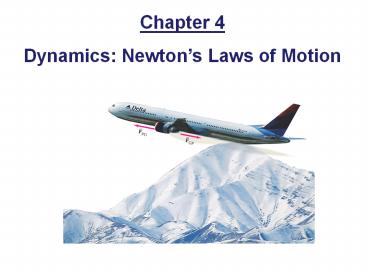Dynamics: Newton - PowerPoint PPT Presentation
1 / 22
Title:
Dynamics: Newton
Description:
Chapter 4 Dynamics: Newton s Laws of Motion Definition of Force A force is a push or pull. Forces can be : Contact Forces Field Forces (Forces at a Distance) Newton ... – PowerPoint PPT presentation
Number of Views:174
Avg rating:3.0/5.0
Title: Dynamics: Newton
1
Chapter 4 Dynamics Newtons Laws of Motion
2
Definition of Force
A force is a push or pull.
Forces can be Contact Forces Field Forces
(Forces at a Distance)
3
Newtons First Law
(Often called the Law of Inertia) Every object
continues in its state of rest, or of uniform
velocity in a straight line, as long as no net
force acts on it.
Inertia Tendency of an object to resist a
change in its motion Mass Measure of inertia of
an object (kilograms)
4
Newtons Second Law
Newtons second law is the relationship between
acceleration and force Acceleration is
proportional to net force on an object and
inversely proportional to its mass.
5
Equilibrium
- A condition in which the net force on an object
is equal to zero. - According to Newtons 2nd Law, if FNet 0, then
a 0 m/s. Object is - a) at rest (v 0 m/s)
- b) moving with constant velocity
6
Newtons Third Law
Any time a force is exerted on an object, that
force is caused by another object Whenever one
object exerts a force on a second object, the
second exerts an equal force in the opposite
direction on the first.
7
A key to the correct application of the third law
is that the forces are exerted on different
objects. Make sure you dont use them as if they
were acting on the same object.
8
(No Transcript)
9
Weight the Force of Gravity
Weight is the force exerted on an object by
gravitational attraction. Close to the surface of
the Earth, where the gravitational force is
caused by the Earth and is nearly constant, the
weight of an object is
10
The Normal Force
The force exerted perpendicular to a surface is
called the normal force.
11
(No Transcript)
12
Friction
On a microscopic scale, most surfaces are rough.
For kinetic (sliding) friction
is the coefficient of kinetic friction, and is
different for every pair of surfaces.
13
Static Friction
Static friction is the frictional force between
two surfaces that are not moving along each
other. Static friction keeps objects on inclines
from sliding, and keeps objects from moving when
a force is first applied.
14
Hookes Law
- Fs kx
- k spring constant
- x stretch distance
15
Tension and Pulleys
- Tension is uniform within a cord/string, pulleys
are frictionless.
16
Apparent Weight
- Scales/Normal Force
- - Measure the normal force using springs
- - Scale reading is equal to weight on a flat,
stationary surface - - Scale reading will change if surface is tilted
or accelerating
17
Terminal Velocity
- For an object in free-fall, when frictional
force of air resistance (drag force) is equal
to objects weight, object is in equilibrium and
will maintain constant velocity.
18
Forces at Angles
19
(No Transcript)
20
Solving Problems with Newtons Laws Free-Body
Diagrams
- Draw a sketch.
- For one object, draw a free-body diagram,
showing all the forces acting on the object. Make
the magnitudes and directions as accurate as you
can. Label each force. If there are multiple
objects, draw a separate diagram for each one. - Resolve vectors into components.
- Apply Newtons second law to each component.
- Solve.
21
Example 1 (g 9.8 m/s2)
22
Example 2































